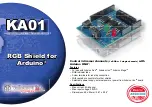UM10503
All information provided in this document is subject to legal disclaimers.
© NXP B.V. 2012. All rights reserved.
User manual
Rev. 1.3 — 6 July 2012
1003 of 1269
NXP Semiconductors
UM10503
Chapter 39: LPC43xx SSP0/1
39.5 Pin description
39.6 Register description
The register addresses of the SSP controllers are shown in
and
Table 870. SSP pin description
Pin
Name
Direction
Interface pin
name/function
Pin description
SPI
SSI
Microwire
SSP0/1_
SCK
I/O
SCK
CLK
SK
Serial Clock.
SCK/CLK/SK is a clock signal used to synchronize the
transfer of data. It is driven by the master and received by the slave.
When the SPI interface is used, the clock is programmable to be
active-high or active-low, otherwise it is always active-high. SCK1 only
switches during a data transfer. Any other time, the SSPn interface
either holds it in its inactive state, or does not drive it (leaves it in
high-impedance state).
SSP0/1_
SSEL
I/O
SSEL FS
CS
Frame Sync/Slave Select.
When the SSPn interface is a bus master,
it drives this signal to an active state before the start of serial data, and
then releases it to an inactive state after the serial data has been sent.
The active state of this signal can be high or low depending upon the
selected bus and mode. When the SSPn is a bus slave, this signal
qualifies the presence of data from the Master, according to the
protocol in use.
When there is just one bus master and one bus slave, the Frame Sync
or Slave Select signal from the Master can be connected directly to the
slave's corresponding input. When there is more than one slave on the
bus, further qualification of their Frame Select/Slave Select inputs will
typically be necessary to prevent more than one slave from responding
to a transfer.
SSP0/1_
MISO
I/O
MISO DR(M)
DX(S)
SI(M)
SO(S)
Master In Slave Out.
The MISO signal transfers serial data from the
slave to the master. When the SSPn is a slave, serial data is output on
this signal. When the SSPn is a master, it clocks in serial data from this
signal. When the SSPn is a slave and is not selected by FS/SSEL, it
does not drive this signal (leaves it in high-impedance state).
SSP0/1_
MOSI
I/O
MOSI DX(M)
DR(S)
SO(M)
SI(S)
Master Out Slave In.
The MOSI signal transfers serial data from the
master to the slave. When the SSPn is a master, it outputs serial data
on this signal. When the SSPn is a slave, it clocks in serial data from
this signal.
Table 871. Register overview: SSP0 (base address 0x4008 3000)
Name
Access Address
offset
Description
Reset
value
Reference
CR0
R/W
0x000
Control Register 0. Selects the serial clock rate, bus type,
and data size.
0
CR1
R/W
0x004
Control Register 1. Selects master/slave and other modes.
0
DR
R/W
0x008
Data Register. Writes fill the transmit FIFO, and reads
empty the receive FIFO.
0
SR
RO
0x00C
Status Register
0x0000
0003
CPSR
R/W
0x010
Clock Prescale Register
0


















